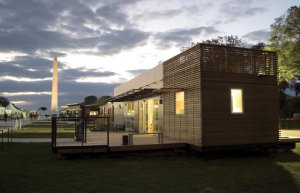
A small, solar-powered village now occupies The National Mall as Washington DC just got a little greener. Teams from universities around the United States and Europe converge on the site to compete in the Department of Energy’s (DOE) biennial Solar Decathlon.
This interactive solar neighborhood sprang up on the National Mall in the evening of September 30, when twenty student- led teams, supported by professional construction personnel, began reassembling their solar homes.
To compete, the twenty teams, which are comprised of students from various universities, are culled from a pool of over forty applicants. They vie for a chance to be in the competition and a grant of $100,000, which is used towards financing their design.
At the heart of the competition is the desire to move solar technology awareness forward. The designers match wits and originality against one another to produce the finest example of totally solar-powered architecture, in order to accomplish this goal.
“They learn from each other; they learn what really works. It’s a wonderful iterative process,” said Richard J. King, who is the contest organizer for the DOE.
As the name of the competition implies, the participants are judged on ten contests, such as “Market Viability” and “Home Entertainment” which evaluate the entrants’ ability to use commercially-available materials in order to demonstrate that a fully sun powered home can be built cost effectively on a wide scale. The competition attempts to show that these modern homes can also accommodate all the modern conveniences that we have come to expect.
That the contest battles this seeming dichotomy is an overarching theme of the Solar Decathlon. In fact, an additional criterium for the competition is a “Communication” contest, in which the teams are challenged to convey their experiences to the public. Usually the participants achieve this by producing appropriate literature and websites, but the Decathlon also allows for a first hand demonstration of the viability of solar technology-- the houses are open to the public for tours and presentations until October 18.
While the prototypes, such as the University of Arizona’s “Seed Pod” and Cornell’s “Silo House” look like something out of science fiction, these homes represent the perfect balance of creativity and functionality. “In our design, a greenhouse serves as a biofilter, providing a plate for food production, greywater filtration, and air replenishment in the surrounding area, “ said Matt Gindlesparger, Project manager for the Seed Pod house. As the teams strive to produce aesthetically pleasing designs using such environmentally friendly strategies as LED lighting that can last fifty times longer than a regular light bulb.
This seems to be a pervasive theme in the competition, in which some teams have opted to use such very modern and cutting edge designs. This is especially evident in the entry from Team Spain of the Universidad Politecnica de Madrid, in which their house utilizes an mobile inverted pyramid on the roof that can move to catch the sun’s rays. “I was really motivated to help. All of us want to continue working on this,” said David Siguenza, who is also an economic student. “We gained a lot of valuable experience.”
On the other hand some teams have focused more on the commercial viability aspect of the competition and have produced potentially ”simple” designs that can enter the marketplace sooner. The University of Illinois at Urbana-Champaign’s Gable House looks draws clearly from a classically simple design-- a barn. In fact, the exterior of the home was recycled from an old barn and uses bamboo as a greener support system within the house. “We set out to prove that there is no schism between new technologies and traditional ways of building homes,” said Camden Greenlee, an architecture student on the team.
In addition to domestic entrants such as Ohio State and Penn State, it includes other international entrants such as Teams Alberta and Ontario, which draw from several area universities for their crew, and Team Germany from the Technische Universitat Darmstadt, who took top honors in the 2007 Decathlon. “We are now part of the solar market; we’re kind of experts. It has become really special,” said Franziska Hartmann, an architecture student at the university.
It’s not the first time solar energy and technology have come into the public eye, but hopefully not the last. The competition’s winner is announced on October 16.

